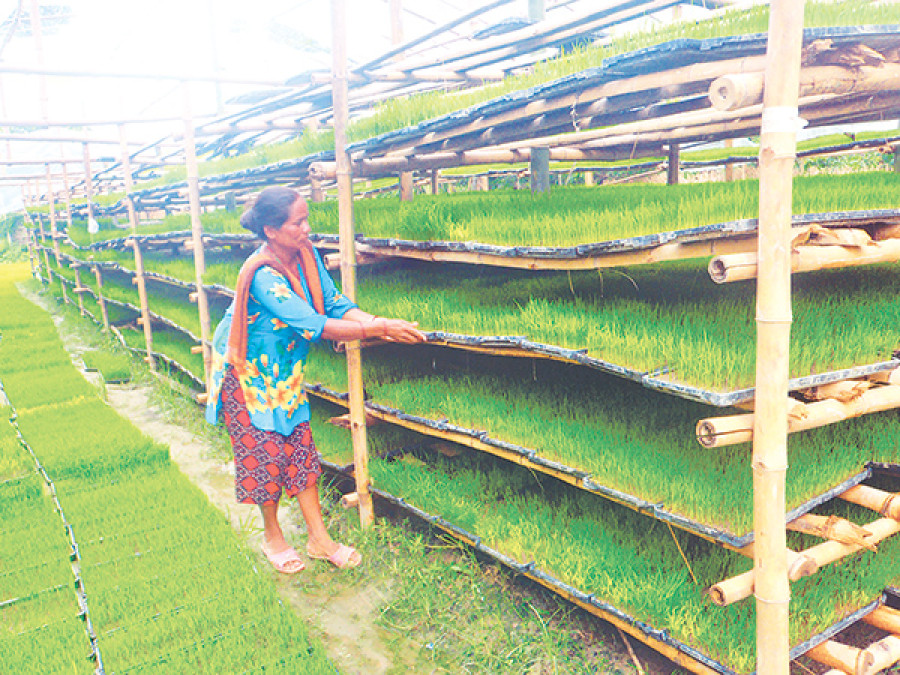Money
Farmers unworried about labour shortage
Farmers have adopted a mechanized sowing technique—a parachute rice transplanting technique that involves sowing paddy seedlings in a nursery under flexible plastic trays.
Bed Raj Poudel
Farmers in Tanmuna VDC in Sunsari district are not worried about not being able to sow paddy seeds and transplant the seedlings on time despite a shortage of farm labourers. They are also not concerned about the availability of farm hands to prepare the seed beds and plough their fields.
The reason they are so confident is because they have adopted a mechanized sowing technique—a parachute rice transplanting technique that involves sowing paddy seedlings in a nursery under flexible plastic trays.
Likewise, they have adopted modern transplanting techniques that are better than manual transplanting. In preparing the nursery seedbed, the surface needs to be level, free of weeds and well drained, but these farmers are not worried nowadays as they used to be in past years.
This season, farmers in Tanmuna, Satterjhor and Chitaha VDCs are transplanting paddy on 407 bighas of land using a paddy transplanter.
Agriculture in Nepal, particularly paddy cultivation, has been a matter of human sweat and draught animal labour. Oxen pulled ploughs to prepare the soil for planting.
The hard labour involved in planting, tilling, cultivating, cutting, collecting, bundling, threshing and loading has remained a farming reality.
Despite the hard labour, incomes are very low. However, modern farm techniques have reduced the costs significantly. For example, transplanting paddy on a bigha of land requires 20 pairs of oxen and 30 workers that cost Rs22,000. However, costs have been slashed to Rs11,500 per bigha by using machines and the time taken has been shortened to one day.
Bhagya Narayan Chaudhary, a local farmer of Chitaha, is delighted to see that such difficult work can be accomplished within a short span of time and at low cost.
Chaudhary, who decided to adopt the system to transplant paddy on his 7 bighas of land, said that the initiative launched by Nepal Agriculture Company had revolutionized agriculture and pushed out traditional subsistence farming. He is a member of the Samjhana Farm Cooperative under the company which has 180 farmers as its members. The cooperative has provided paddy transplanters and harvesters to remove the difficulties and encourage farmers to adopt modern farm techniques. “It has drastically reduced farm costs and farmers’ worries,” said Ashok Majhi, another farmer of Tanmuna. He had sowed paddy seeds on plastic trays and transplanted the seedlings using machines.
Farm mechanization has brought wonders to a large number of farmers in the villages as formerly they used to spend at least seven days to complete paddy cultivation in the traditional system.
Ashok Chaudhary said that before the adaptation of modern techniques, it used to cost him Rs30,000 to cultivate paddy on less than 1.5 bighas of land. His spending has dropped to Rs19,000 now. “Moreover, it saves time, and now I have more time to spend on other things.”
A group of six women are involved in producing paddy seedlings at a cooperative and have prepared seedlings for 30 bighas of land. Farmers said that production had also increased significantly after using machines.
For example, farmers used to produce 3.6 tonnes of paddy per bigha using traditional farming practices, but now the output has swelled to 5.2 tonnes. Many farmers are being attracted to mechanization and it has had a spill over effect in other areas too.
National Agriculture Census 2011-12 shows that Nepal’s agriculture has made slight progress in terms of mechanization.
As per the survey, 22.04 percent of the farm households in the country used tractors and 20.96 percent reported using threshers on their farms.
However, power tillers are not popular among farmers as only 1.97 percent reported using them in their farming operations. Still, 28.01 percent of the holders are using the most basic farm technology—the iron plough. Users of iron ploughs made up 26.1 percent of the farm households in the last census.




 9.12°C Kathmandu
9.12°C Kathmandu















